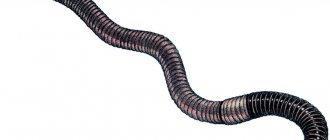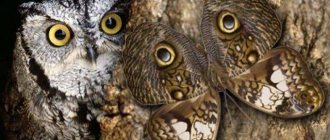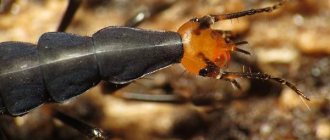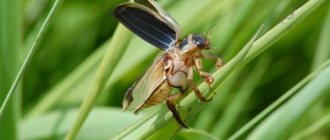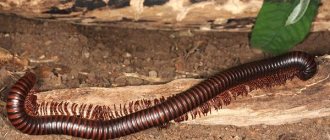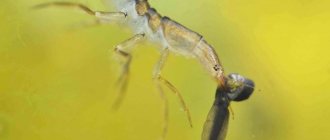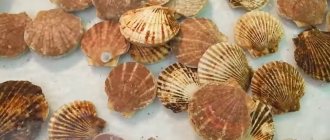general description
The name admiral appeared due to the similarity of the red stripes on the wings with the admiral's stripes. But there is another version - “admirable” or “wonderful” in English. But the original Latin name is different - Vanessa Atlanta, in honor of the Greek huntress who lived in the forest and ran the fastest.
It is simply impossible to determine the population of the admiral, because the number changes significantly every year. Butterflies do not live long and are highly susceptible to external factors. In addition, the migratory lifestyle complicates any possible calculations. At the moment in Russia the admiral is excluded from the Red Book.
Butterfly drawing: option No. 1
- a simple pencil, as well as yellow, brown, orange and green;
- marker;
- ruler;
- eraser.
Steps for drawing a butterfly:
1. We will start this drawing by depicting simple lines and geometric shapes. First we need to draw a vertical line on a piece of paper.
2. Next, draw the body of the butterfly symmetrically. It will be in the shape of a small circle, oval and semi-ovals. We will also draw antennae in the form of small stripes.
3. Next, draw a transverse line in the middle of the silhouette. We need this line for further drawing.
4. From the horizontal line with a pencil, draw one arc to the sides, left and right.
5. To the ends of the arcs we will draw one more from the body. In this way we get the upper halves of the butterfly's wings.
6. Now let’s draw the lower parts of the butterfly’s wings in the form of circles.
7. Through each section of the wing we will draw a line that will extend slightly beyond the circle.
8. Draw the tips of the wings below, making them wavy.
9. We change the shape of the upper parts of the wings. We make sure to make them symmetrical and without sharp corners. Everything should look gentle and beautiful!
10. We detail the body of the butterfly: we finish the eyes in the form of tiny circles, the ends on the antennae, and smooth out the shape.
11. At this stage, you should remove all unnecessary auxiliary areas and prepare the drawing for applying the outline and color. In these sketches you can already recognize the future butterfly!
12. Next, with a marker we begin to outline each wing and antennae, and also do not forget about the body, where the butterfly’s head with eyes is located. In some places you can make a beautiful thickening of the edges. This is very easy to do: just run a marker over this area not once, but two or three times.
13. Then we begin to decorate the butterfly - in the middle of each wing we apply patterns with a pencil according to our discretion and desire. You can also leave them untouched and simply paint them with bright colors.
14. If you prefer patterns, then you should outline them with a black marker or felt-tip pen.
15. Now we begin to paint the upper wings yellow.
16. Add bright orange accents.
17. We paint the lower wings with green pencils.
18. Draw the body and head with brown pencils.
Now we have a beautiful step-by-step drawing! We were able to draw a winged butterfly!
Appearance
Together with the urticaria and lemongrass, the admiral belongs to the same family of nymphalids. The front wings usually have several white spots of varying sizes. The hind wings are completely black, with a red border. Up close, you can easily notice that this black is not at all uniform, but consists of many different shades flowing into each other.
The admiral is a medium-sized butterfly with a wingspan of up to 6.5 cm. The wings are almost triangular, but wavy along the outer edge. In some places you can see small bluish inclusions. Thanks to this coloring, an admiral with folded wings is almost impossible to notice in a tree or on the ground.
The antennae are black, but with white rings along their entire length. The proboscis is long and curled when at rest. The segmented legs consist of five parts, with the short front ones not participating in movement. The butterfly's abdomen is brown, brown or black. Males and females differ little from each other.
Migration is linked to nutrition
Butterfly
The range of the admiral's butterfly is only slightly smaller than that of the burdock, and within this range it is found in many habitats - suburbs, parks, gardens, wooded edges and paths, around wetlands, floodplains, wet fields and ditches - anywhere it may be close to various species of nettle, which are food plants for its caterpillar.
Most sources limit the caterpillars to nettles, but some add milk thistle, willow, and/or members of the plant family Cannabaceae (yes, that's a plant family), a family that mainly consists of curry and hops. It is believed that adults do not nest on flowers, but live on tree trunks.
In the afternoon, males are said to defend territories with semi-light-edged clearings and search for females to whom they are attracted. The question is whether the males actually defend a territory or simply chase around until they determine their species and sex by taking to the air several times. Some butterflies fly in a spiral upward to the tops of trees. Females fly slowly and purposefully in search of plants to lay eggs on. Butterflies scratch the surface of the leaf with their bristly legs and then taste it. If the admiral butterfly recognizes the plant, it will lay an egg on the upper surface of the host plant's leaf. The hatched caterpillar folds the leaf around itself and takes refuge inside.
In late April and early May, female admiral butterflies can be seen flying around nettle patches in forest clearings. They periodically settle on the leaves of the nettle Urtica dioica, on which they lay one egg. Typically a dozen or so eggs will be laid on any significant nettle leaf. Oviposition is interspersed with periods of basking and nectarization - typically in blackthorn, crabapple and wild cherry.
The adult offspring, which may be of British or European descent, are less fussy about where they lay their eggs. They will lay eggs in any sheltered, sunny, low-lying habitat where, for example, a food plant grows.
On sunny days, butterflies often bask on tree trunks, always taking a position with their heads down or to the side. In warm but cloudy weather, they like to bask on the leaves of blackberries, hazels and other shrubs.
Species of admiral butterfly
Scientists distinguish only two main subspecies of the admiral butterfly, depending on the geography of their habitat. But other butterflies are often confused with them.
Red Admiral
The most common species in our latitudes with orange-red stripes on brown, almost black wings. They inhabit the temperate climate zone of Europe and Asia, as well as North America.
White Admiral
The stripes of this butterfly are white, and the base of the wings is jet black. Spectacular contrasting colors allow for excellent camouflage from predators. The white admiral lives in forests and is distinguished by the specificity of its flight, when it alternates strong flapping of its wings with soaring.
Jay (50 photos): description of the bird, what it eats and where it lives
Butterfly nutrition and protection of feeding territory
In early spring, nectar awaits red admirals on yellowish birch catkins and blackthorn and hawthorn flowers. Favorite sources of summer nectar include dogwood, agrimonia, blackberry, marjoram, thistle, burdock, burdock, and ivy.
They also visit dung or absorb mineral salts from moist soil and visit drops of sap on oak trunks. In orchards they will eat fallen apples or pears.
Admirals are one of the most intelligent species of butterflies - they have the ability to get used to, that is, learn to react less strongly to stimuli that turn out to be harmless. Upon entering their territory, the intruder is immediately investigated.
admiral butterfly on a leaf
In the event of a human invasion, the admiral butterfly will circle several times and try to find out if the person is a threat. If he or she seems harmless, the butterfly becomes increasingly brave - the butterfly gets used to the presence of a person and again the butterfly behaves as if no one is there.
admiral butterfly food
On the other hand, if the intruder reacts to the butterfly by chasing it, it becomes wary, and further pursuit will be enough to drive the butterfly out of the area for a few minutes.
Lifestyle
All behavioral and lifestyle features are directly related to constant migrations and a short life cycle. But we managed to systematize the information in a little more detail!
Habitats
The admiral butterfly is a very common species that is found almost everywhere. Be it Southern Europe, Central Asia, Siberia, Africa, New Zealand or Haiti - you will find these butterflies everywhere.
Diet
The diet of the admiral butterfly is very diverse. This is flower nectar, tree sap, rotting fruits and even bird droppings. Taste buds are located on the tips of the legs, so the butterfly only needs to stand on the food to taste it.
Migrations
Admiral butterflies are active migrants that spend most of their lives on the move. They travel thousands of kilometers in search of food and comfortable conditions for reproduction. An admiral who has just arrived from a long journey can be easily distinguished by his tattered wings.
Wintering
Admiral butterflies also migrate for the winter. In general, they can hibernate, but they prefer to go to warmer climes - to the islands, North America or Africa. Before hibernation, they hide under the bark and all this time until spring they feed on accumulated fat deposits. Not all butterflies survive the winter.
Lifestyle and habitat
The species' distribution range is quite wide and covers territories from Canada to Guatemala and Scandinavia. The insect lives in the European part of Russia, as well as in the eastern regions of China. In addition, you can see Vanessa Atlanta on the islands: Canary, Azov, Bermuda, Hawaii. The butterfly was artificially brought to New Zealand, where it successfully took root.
Representatives of the species cannot survive the cold , so they migrate over impressive distances to escape the frost. Prefers to settle in swampy areas, wet forests, and water meadows. However, despite their love for warmth, it is the Admirals who are the last of the butterflies to leave their native lands. In northern Europe they are found until the onset of winter.
The Admiral butterfly feeds on various foods:
- Adult insects prefer fruits, including fermented and fallen ones.
- They also eat the sugary secretions of trees.
- Bird droppings.
- If there is no other food, they can feast on the nectar of flowers (preference is given to clover, asters, and milkweed).
- The caterpillar of the Admiral butterfly eats the leaves of nettle, thistle, and hop.
The adult individual absorbs nectar using its unique oral apparatus - the proboscis, which is capable of curling and opening. On the Admiral’s front legs there are sensitive villi equipped with taste repeaters - they help the butterfly “taste” the delicacy.
Reproduction of the admiral butterfly
Admirals have a courtship period, during which males conquer territory and intercept passing females. They have to gain favor for quite a long time, and in the process the butterflies are very vulnerable because they hardly react to external factors.
The female butterfly lays one egg at a time in the leaves of thistle, hop or nettle, and then dies. Caterpillars live in these rolled up leaves and feed on them. Admiral larvae are golden, caterpillars are yellow, green, black or brown, without a stripe on the back. But there may be yellow stripes on the sides.
Over the course of a week, the caterpillar develops and forms its shelter. Then it grows for a long time, until about the end of summer, and only then a butterfly emerges from the pupa. On average, the entire development cycle from egg to adult lasts about 2 months. The average lifespan of an admiral is approximately six months, so two generations can change in a calendar year.
Waxwing (60 photos): description of the bird, where it lives and what it eats
Reproduction and lifespan
With the arrival of stable warmth in the spring, the Admiral butterfly begins its mating season. After this, the females lay eggs one at a time on the leaf from its upper side. After a week, greenish larvae about 1.8 mm in size appear from them. They begin to actively feed and grow accordingly. Throughout the entire development period, which lasts 1 month, the Admiral caterpillar molts five times.
The larvae make shelters for themselves by wrapping themselves in leaves, which they feed on. At the last stage of development, the length of the caterpillars is 2.5-3 cm. At this time, their activity decreases, as preparation for pupation begins. To do this, they build a house, eating the base of the plate, but leaving its veins. After this, fold the sheet in half and glue the edges with a special secret. As a result, the shelter hangs freely on the veins. And inside it there is a gray Admiral pupa with small spikes and golden spots. Its size reaches 2.2 cm.
At a temperature of +300C degrees, the imago appears within a week, and at a temperature of +11 to +180C this occurs after 18-45 days.
Caterpillar
After birth, the butterfly sits in one place for several minutes until its wings dry out. Within a day, she is already capable of reproducing offspring. Under favorable conditions, the Admiral's life expectancy is 10 months. Two insect offspring appear per season.
Admirals in captivity
Surprisingly, admiral butterflies can be kept in captivity. To do this, it needs to emerge from the caterpillar stage so that it can better adapt to new conditions. You need an aquarium without water, but with food plants and a net on top.
There should always be fresh air and high humidity. Vertical branches are also needed so that the young butterfly can spread its wings. The diet consists of fruit juices, honey drinks and fruits.
Keeping at home
Some enthusiasts would like to keep a butterfly at home, but for this it needs to create conditions favorable for life.
You can keep the moth in an aquarium or plastic container, covering it with a net on top. Place the grass at the bottom of the container, sprinkling it with water periodically. You also need to place vertically located branches inside on which the moth can spread its wings.
The optimal maintenance regime is temperature +24...300C and humidity 70-90%. To feed, you should soak a cotton pad in sweet syrup prepared in a ratio of 1:6 and bring it to the moth. To recognize food, the butterfly only needs to touch it with its forelimbs. The food can be pieces of overripe apples, pears, and plums.
You need to feed the insect once a day. The lifespan of a moth at home is only 3-4 weeks.
Benefits and harms
There is practically no harm from the admiral butterfly from an economic point of view. Adults are even useful because they participate in plant pollination. But caterpillars can actually eat leaves significantly, especially in hop plantings.
Robin (50 photos): description of the bird, where it lives and what it eats
Ionic drink for butterflies
A flock of butterflies hovering over the head of a large river turtle is not a rare occurrence and does not seem unusual. Much more interesting is the reason why the moths circulate around the animal: they are trying to drink the tears of the turtle. This phenomenon can be observed in South America.
Turtle tears contain sodium, an important mineral rarely found in the western Amazon, far from the ocean. Unlike Admirals, carnivorous turtles get enough sodium from their meat diet. Herbivores must obtain sodium and other essential minerals in more complex ways.
Fortunately, turtle tears are not the only source of minerals for the Admiral butterfly. Sodium is also found in human sweat, in the urine of various animals, in dirty jars and even in puddles.
Admiral butterfly – photo
Can you doubt the beauty of a butterfly? We are sure that it is not, and we have prepared a large photo selection to prove it!
Did you like the post? Subscribe to our channel in Yandex.Zen, it really helps us in our development!
Butterfly habitat
The habitat of butterflies of this species includes most countries of the northern hemisphere. The Admiral can be found in the following regions:
- North America;
- Western and Central Europe;
- Caucasus;
- Middle Asia;
- North Africa;
- Azores and Canary Islands;
- island of Haiti;
- island of Cuba;
- northern part of India.
Insects have also been artificially introduced to such remote corners of the planet as the Hawaiian Islands and New Zealand.
Butterflies of this species most often choose to live in parks, gardens, forest glades, the banks of rivers and streams, fields and meadows. Sometimes the Admiral can be found in the swamps.
Hebe the Bear
The she-bear Hebe lives in the steppe zone of our country. The wingspan of this butterfly reaches 55 millimeters. Their forewings are light, have black spots at the outer edge, and in the center there are 3 narrow black bands. The hind wings are reddish with black spots. These are night butterflies. They fly from May to July.
Moths with a thick, shaggy body and colorful wings are representatives of the bear family. There are 11 thousand species in the world. The greatest diversity is noted in South America - 5 thousand species; 150 species of bear butterflies live in Russia. The family owes its unusual name to the appearance of its caterpillars. Their bodies are covered with thick black or brown hairs. The larvae were compared to bear cubs, and their parents were compared to mother bears. Moths have different sizes, the largest are more than 11 cm. The brightly colored lady bear butterfly lives in the temperate zone. It can be found on wet edges, along rivers and streams. In all habitats, insect numbers are declining. They are included in the Red Book in Russia and Ukraine.
Interesting Facts
There is no single version of the origin of the name of this insect.
Some believe that its colors are similar to the military uniforms worn by admirals in Tsarist Russia in former times. The red bands on the wings of the butterfly resemble stripes. It is believed that the name of the butterfly is a slightly modified French word admirable, which means “beautiful.” The English sometimes call Nymphalida aldermann, which translates as “advisor.”
The flight pattern of these lepidopterans is interesting. It seems completely chaotic and uncontrollable. It seems that the butterfly is simply picked up and whirled by the wind. But it turns out that this is no coincidence. The unpredictable trajectory makes it difficult for birds and other predators to catch prey.
There have been cases where Vanessa atalanta caterpillars demonstrated coordinated behavior. When an external threat appears, they unanimously raise their upper body and display hard spines, confusing and scaring off the aggressor.
When migrating to warm regions, the Admiral can cover long distances. He easily reaches North Africa, starting his journey in Europe. True, not everyone experiences such a voyage. Individuals that survived the journey to warm countries and returned back to the European continent can be recognized by their faded and slightly frayed wings.
Admiral is sometimes confused with common urticaria, which is also widespread in the Middle Zone. It is noteworthy that caterpillars of both species feed on the same plants. The Admiral butterfly is larger and brighter than its counterpart and has a more subtle wing color, in which black rather than orange colors predominate. But the caterpillars of these two species are indeed very similar.
Vanessa atalanta has not only a sonorous name, but a remarkable appearance. Watching a butterfly is pleasant and interesting; both adults and children enthusiastically indulge in this activity. The admiral deserves protection and careful treatment. In some countries it is listed in the Red Book.
Tags: butterfly
Classification
The classification of Lepidoptera is very complex and confusing, and is still constantly changing. The only constant is that there are nocturnal butterflies and those that are active only during the daytime.
In the simplest of schemes, they are all divided into four suborders:
Toothed moths. This includes the smallest individuals ranging in size from 4 to 15 mm; there are about 160 species. These include golden and marigold smallwings.
Proboscisless, with a wingspan of up to 25 mm. They have many similarities to moths. Fir cone moth and flour moth are representatives of this suborder.
The third species of these insects is represented by only one family - heterobatmyas.
The largest distinguished suborder consists of proboscis. It has more than 150 different species, which are included in dozens of families.
The individuals of this suborder are very diverse. This includes the family of Swallowtails (Swallowtail, Queen Alexandra's Birdwing, Glory of Bhutan), Nymphalidae (Admiral, Peacock's Eye, Wren, Mourning) and Hawkmoths. The armyworm family alone has about 35 thousand species.
Etymology of the name
The admiral day butterfly was described by Carl Linnaeus in 1758 from specimens collected in Sweden. The name of the species is given by the name of the heroine of the ancient Greek myth. Atalanta was the daughter of King Jasius of Arcadia and Clymene. From the ancient Greek language this name is translated as “unshakable.” The father wanted to have only sons and therefore ordered his daughter to be left on Mount Parthenius immediately after birth. The girl was nursed by a bear and later found by hunters in the forest. Atalanta became famous after she and her lover Meleager took part in the hunt for the Calydonian boar.
The Russian name for the butterfly has nothing to do with the military rank of “admiral”. The insect is so called for the bright colors of its wings and comes from the English word “admirable”, which translates as “wonderful”.
The English name of the insect, red admiral, translates as “red admiral.”
Photo credit: Toni Wöhrl, CC BY-SA 4.0
